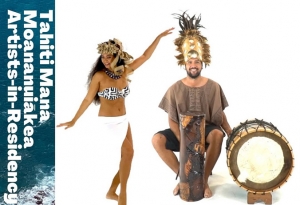The University of Hawaiʻi at Mānoa Department of Theatre and Dance has launched a pilot program to help diversify the curriculum of the culture and arts from across the Pacific. This spring, the inaugural Moananuiākea Artists-in-Residency program welcomed dance company Tahiti Mana to share the vibrant dances and stories of French Polynesia.
The residency is aimed at offering students, faculty and the broader community access to free workshops, educational outreach and cultural exchange talk story sessions centered around artistic traditions from across Moananuiākea, which is the oceanic region for Indigenous people from areas across the Pacific.
“The overall mission and vision of the program is to address the educational diversity gap of embodied knowledge for the people of Moananuiākea,” said Lorenzo Perillo, an assistant professor in the Theatre and Dance Department. “Since the 1970s, cultural stewards and activists have led a resurgence to connect to the practices, the arts, the dances of this region. What we’re doing here is connecting to that resurgence.”
ʻOri Tahiti (Tahitian dance)

Dancing duo Manarii and Nalini Gauthier were the first resident Moananuiākea artists at UH Mānoa. They held dance workshops on campus that showcased traditional ʻori movements and motions and live drumming.
“Despite the fact that Tahitian dance was forbidden and discouraged for over 100 years, it’s thriving worldwide today and that’s a beautiful thing,” Nalini explained. “Our mission is to continue that, perpetuate it so that our children can practice their ancestral dances and songs.”
Her husband, Manarii, was born and raised in Tahiti and immersed in ʻori Tahiti from birth. He studied under his mother, a former dancer of Coco Hotahota’s premiere group, Te Maeva and also learned from world renowned teacher Makau Foster of Tamariki Poerani. The seasoned drummer and dancer is thrilled to share the traditions from his island home.
“We just want to be able to stay connected to our ancestors by sharing what we are, our culture, to the people who want to know,” he said.
The pilot program is a five-year initiative, and Perillo hopes to invite a wide spectrum of artists to help incorporate more Indigenous people into the department and UH system.
“These cultural practices are not frozen in the past,” said Perillo. “These artists and communities are thriving in the contemporary and another part of preservation is also innovation and creativity and community building. For us, that’s really finding a way to have space in the institutions that serve our public to really hold that space for each other.”
This program is funded by a SEED Initiative for Diversity, Equity, Access and Success grant and the UH Mānoa Center for Pacific Island Studies and theatre and dance department.
This program is an example of UH Mānoa’s goal of Becoming a Native Hawaiian Place of Learning (PDF) and Enhancing Student Success (PDF), two of four goals identified in the 2015–25 Strategic Plan (PDF), updated in December 2020.

